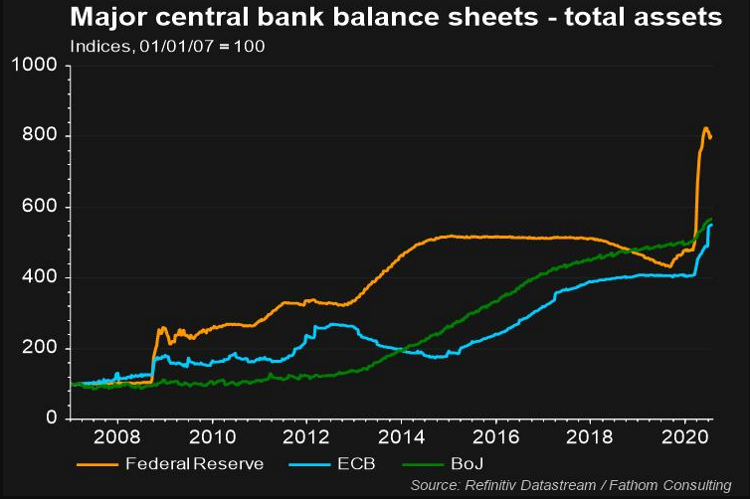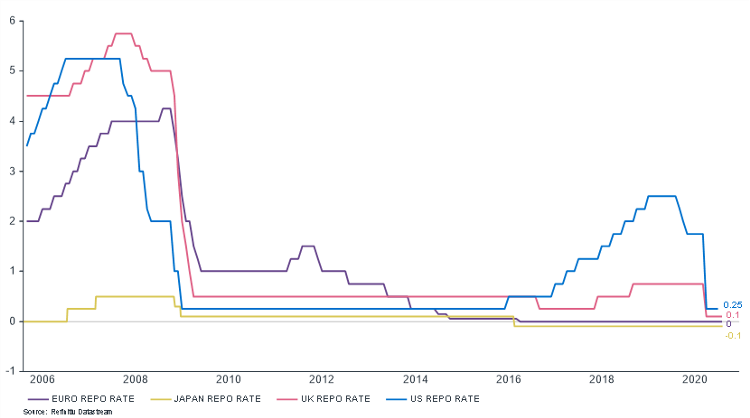Central Banks & Governments COVID-19 Response Efforts
Brief overview of phenomenal central bank and government pandemic relief packages


In 2020 trillions of dollars in relief programs have been announced by the world’s major central banks in an effort to support economies during the COVID-19 pandemic. The level of support can easily get lost when comparing countries to one another, but as seen in the below chart, when compared to the 2009 global financial crisis relief packages, the extent is clear and unprecedented. Support has not been limited to relief packages but includes sensational decreases in interest rates, as reflected below, and debt relief from global institutions such as the International Monetary Fund (IMF). More detail on Government and central banks will be provided below:


South Africa & South African Reserve Bank (SARB)
The SARB should be commended for the speedy liquidity support they provided to the markets from March through secondary market bond purchases. This combined with reduced bank deposit requirements and a 3% reduction in interest rates over the year has reduced pressure on both institutions and citizens. You can find further detail here.
Alongside the support received from the SARB, South Africa has received support from a variety of global institutions to fund their relief program. The most substantial portion of the funding is from the IMF loan, first formally announced by Finance Minister Tito Mboweni in his June 2020 supplementary budget address (you can find the link to our breakdown of this here). The IMF has approved $4.3 Bln through their rapid financing instrument. The terms of the loan include a low interest rate of 1.1% with repayments required to begin in 3.25 - 5 years’ time. Considering SA’s current fiscal pressures these limited conditions are better than market expectations. More detail on the IMF loan can be found here .
Further support has been given by the African Development Bank and New Development Bank (formally known as BRICS Development Bank), of approximately $288 Mln and $1 Bln loans respectively.
China & The People’s Bank of China (PBC)
The value of the first quarters’ support from the PBC is estimated at RMB7.1 Trl. The support was provided through monetary policy and credit relief, rate cuts and reverse repo operations have been used as the main tools used since February 2020.
European Union & European Central Bank (ECB)
The ECB’s has provided the majority of support to the euro area. Monetary policy being the main tool through which support has been provided, as by the Union’s structure, fiscal policy is a tool used at a national level. In response to the pandemic the ECB established the Pandemic Emergency Purchase Programme to repurchase assets and support market liquidity conditions thereby providing a tool to stabilise financial markets in the medium term. At the beginning of June, the PEPP was increased to €1.35 Tln (from €750 Bln).
On a national level, liquidity support has been provided at around 20% of EU GDP. You can find a detailed blog on the ECB response efforts response here. To align with their long-term predictions that growth recovery will only occur at the end of 2022, the PEPP
program is scheduled to run until 2023.
Japan & Bank of Japan (BOJ)
The Bank of Japan used a variety of mechanisms to support the stability and liquidity of their financial markets. These include a corporate financing support program, unlimited government bond repurchases, as well as real-estate investment trust and exchange traded fund repurchases. The corporate financing program total of ¥120 Trl is split between corporate bond purchases (¥20 Trl) and Special Funds-Supplying Operation (¥100 Trl), which offers 1 year, 0% interest rate loans to small and medium sized businesses. An excellent summary of the measures taken can be found here.
United Kingdom & Bank of England (BOE)
The Bank of England has created an excellent summary that you can find here detailing their support programs. Notably they have dropped interest rates to an all-time low of 0.1% (March 2020). The BOE are further offering banks and building societies extremely low interest rates on long term loans, increased bank funding for small-medium sized companies, and providing business support to ensure cashflow for salaries and supplier payments for larger companies (up to £200 Mln pounds from £50 Mln). Additionally, in May, the UK extended their mortgage payment holiday by a further 3 months.
United States & Federal Reserve (FED)
With the combination of the COVID pandemic and the US elections around the corner, economic stability is even more topical than ever before. The original stimulus package is due to end on Friday 7th August and congress is still debating the next phase. Most of the pandemic support funding resides within the $2.3 Tln Coronavirus Aid, Relief, and Economic Security Act (CARES Act). The act focuses on preserving jobs, and assisting small businesses and families impacted by the pandemic.
The latest announcement from the FED in July left interest rates low and unchanged at 0.25%, after cutting rates by a total of 1.5% in 2020. In the same press release they confirmed the continuation of the repurchase program to ensure market stability but did not provided detailed numbers or dates. The FED have also extended their foreign and international monetary authorities (FIMA) facility, to ensure continued dollar liquidity for foreign markets into 2021. Lending facilities have too been extended until the end of December (originally scheduled to end on 30 September).
The support from central banks and governments has been speedy and consistent. Central banks have become the primary support mechanism everyone is looking towards and in many instances have become the market which is, arguably, well outside of their mandate. The below timeline represents how banks have continuously adapted their support as the pandemic conditions advanced starting in February this year. Central banks have pledged to continue support for as long as necessary, but we do need to start looking ahead to the IMF and other global economic institutions for their global growth forecasts to contemplate how this new debt will be repaid.
| DateMYear | CountryCountry | Monetary Policy Measures |
|---|---|---|
| 23-Jul-20 | South Africa | SARB cuts main lending rate by 25 bps to 3.50%. |
| 18-Jun-20 | United Kingdom | Increases bond-buying programme by 100 billion pounds. |
| 18-Jun-20 | China (Mainland) | Cuts rate on 14-day reverse repurchase agreements to 2.35% from 2.55%. |
| 04-Jun-20 | Euro Zone | ECB increases the size of its Pandemic Emergency Purchase Programme to 1.35 trillion euros from 750 billion euros and extends it until June 2021 at the earliest, pledges to reinvest proceeds until at least end-2022. |
| 26-May-20 | Japan | BOJ offers to pump 1.7 trillion yen into the economy under its lending scheme. |
| 22-May-20 | Japan | BOJ launches its own version of the U.S. Fed's "Main Street" lending programme to channel nearly $280 billion to small businesses. Extends to March 2021 emergency relief announced in March and April. Extends the term of loans for a lending scheme to six months from three months. |
| 21-May-20 | South Africa | SARB cuts main lending rate by 50 bps to 3.75%. |
| 10-May-20 | China (Mainland) | PBOC says will step up counter-cyclical adjustments and make monetary policy more flexible. |
| 30-Apr-20 | Euro Zone | ECB lowers interest rates on long-term loans for banks (TLTROs) to as little as -1.0%, launches a similar new loan scheme called Pandemic Emergency Longer-Term Refinancing Operations or PELTROs. |
| 29-Apr-20 | United States | Fed broadens help for local governments, offering to buy bonds of up to three years' duration from counties with as few as 500,000 residents and cities with as few as 250,000 residents. |
| 27-Apr-20 | Japan | BOJ pledges to buy unlimited amounts of bonds; will boost by three-fold the maximum amount of corporate bonds and commercial debt it buys to 20 trillion yen. |
| 24-Apr-20 | China (Mainland) | PBOC cuts one-year interest rate on its targeted medium-term lending facility (TMLF) by 20 bps to 2.95% from 3.15%. |
| 24-Apr-20 | Japan | Central bank cuts key interest rate by 50 bps to 5.50%. |
| 20-Apr-20 | China (Mainland) | PBOC cuts 1-year loan prime rate by 20 bps to 3.85%, 5-year was cut by 10 bps to 4.65% from 4.75%. |
| 15-Apr-20 | China (Mainland) | PBOC says was lowering one-year medium-term lending facility (MLF) loans to financial institutions to 2.95%, down 20 bps from 3.15% previously. |
| 14-Apr-20 | South Africa | SARB reduces main lending rate by 100 bps to 4.25%. |
| 09-Apr-20 | United States | Fed rolls out $2.3 trillion to backstop "Main Street" local governments and small and mid-sized businesses. |
| 03-Apr-20 | China (Mainland) | PBOC says will cut reserve requirement ratio (RRR) for small banks by 100 bps, releasing around 400 billion yuan. It will be implemented in two phases - first 50 bps cut will be effective April 15 and a second 50 bps cut will be effective May 15. |
| 02-Apr-20 | United Kingdom | BoE says will double the size of its corporate bond purchase programme to at least 20 billion pounds. |
| 31-Mar-20 | United States | Fed broadens access to dollars with repo agreements for foreign central banks. |
| 30-Mar-20 | China (Mainland) | PBOC lowers the seven-day reverse repo rate to 2.20% from 2.40%. |
| 26-Mar-20 | Euro Zone | ECB eliminates cap on how many bonds it can buy from any single euro zone country. |
| 25-Mar-20 | South Africa | SARB announces a programme to buy bonds on secondary market. |
| 23-Mar-20 | United States | Fed promises unlimited, open-ended QE, including purchases of corporate and municipal bonds. |
| 19-Mar-20 | United Kingdom | Bank of England cuts interest rates in two emergency meetings on March 11 (50 bps) and March 19 (15 bps), taking the rate to a record low of 0.10%; announces 200 billion pounds of bond purchases. Introduces new programme for cheap credit and reduces capital buffer. |
| 19-Mar-20 | Euro Zone | ECB adds another 750 billion euros in QE, taking the total to about 1.1 trillion euros this year, adds Greek government debt to portfolio of bonds it would purchase. |
| 19-Mar-20 | South Africa | South African Reserve Bank cuts main lending rate by 100 bps to 5.25%. |
| 18-Mar-20 | United States | Fed rolls out third emergency credit programme in two days; aimed to ensure liquidity in money market mutual funds. |
| 17-Mar-20 | United Kingdom | BoE corporate financing facility will buy commercial paper with a maturity of up to 12 months from businesses that had a pre-crisis investment-grade credit rating or similar. |
| 16-Mar-20 | Japan | Bank of Japan ramps up purchases of exchange-traded funds (ETFs) and other risky assets, including corporate bonds. Is also creating a new loan programme to extend one-year, zero-rate loans to financial institutions. Planned annual increase in the Bank's government bond holdings held at 80 trillion yen. Introduces new lending facility worth 8 trillion yen. |
| 15-Mar-20 | United States | Fed cuts interest rates in two emergency meetings on March 3 (50 basis points) and March 15 (100 bps), taking the federal funds rate to 0-0.25%. Cuts the discount window rate by 150 bps. |
| 13-Mar-20 | China (Mainland) | PBOC cuts amount of cash banks must hold as reserves for the second time this year, releasing 550 billion yuan. |
| 12-Mar-20 | Euro Zone | ECB cuts interest rate on Targeted Long-Term Refinancing Operations (TLTROs) by 25 bps to -0.75%. Adds 120 billion euros to existing asset-purchase programme of 20 billion euros a month. |
| 25-Feb-20 | China (Mainland) | PBOC offers easier funding for small and medium-sized businesses, increasing yuan re-lending and re-discount quotas by 500 billion yuan; increases policy banks' loan quota by 350 billion yuan. |
| 20-Feb-20 | China (Mainland) | People's Bank of China cuts one-year Loan Prime Rate by 10 bps to 4.05%, after various liquidity injections and other policy easing earlier in the year. |













